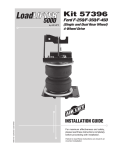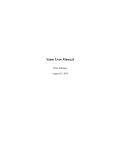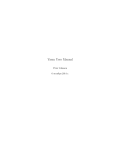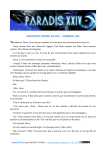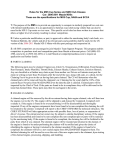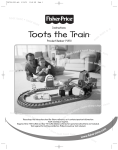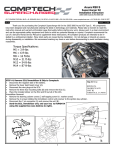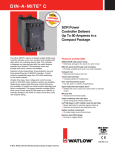Download Acura CL 2003 Instruction manual
Transcript
Acura 3.2CL-S Supercharger Installation Instructions (2003 6-speed ONLY) 3239 MONIER CIRCLE, STE.5 • RANCHO CORDOVA, CA 95742 • 916.635.4550 • FAX 916.635.4632 • www.ct-engineering.com • VERSION: INS-104 6.20.2008 Thank you for purchasing the CT Engineering Supercharger Kit for the 2003 Acura 3.2CL Type-S 6 speed. All components have been designed and manufactured utilizing the latest technology and materials. Please take a moment to read this instruction manual and warranty information page thoroughly before starting any work. CT Engineering recommends the use of a Genuine 2003 Acura 3.2CL Type-S 6-speed Service Manual to supplement these instructions. All CT products are intended to be installed by a professional installer. We recommend marking any hose or wire before disconnecting to avoid confusion during reassembly. Remember to always use jack stands to support the vehicle when a car lift is not available. Always work in a clean environment and use the appropriate safety equipment and tools to avoid any potential damage or injuries. **Before starting, CT Engineering recommends locating the radio code for your particular vehicle and write down the frequencies for the radio’s preset buttons, so the radio can be reactivated and restored after completion of this installation. Additional items needed before starting installation: • Torque Wrench • Sanding disc or cut-off wheel • Size 51R battery Installation facility; please make sure the owner of the vehicle is given a copy of the instructions and super- 1 Parts Drawing—CT Engineering Supercharger—Acura 3.2CL-S 6-speed The CT Engineering Supercharger comes complete with all parts shown in parts drawing. Please take a minute before starting installation and recheck parts in box match “Supercharger Check List” provided in kit. Each blower kit is checked twice for completeness before leaving CT, but in case something was not included, please notify us before starting installation. Sales/technical support: 916.635.4550 Step #1 • Disconnect Negative battery terminal • Drain coolant from the radiator. • Remove plastic engine covers. • Disconnect Positive battery cable. • Remove battery tie-down, battery & plastic battery tray. • Remove stock air box lid, filter & air box bottom (A). • Remove wiring harness from clip (B). Remove 6 mounting bolts (C), and remove the mountA ing bolt (D), then remove the tray base (E) and tray base bracket (F). • Label & disconnect hoses from air inlet tube. Loosen clamp and remove tube. 2 Step #2—Bumper / Lower Air box • On most models: The lower airbox is accessible and removable without removing the bumper. Remove the 4 screws holding the lower splash guard to the bumper and move splash guard enough to access the airbox mounting screws (G). • Lower & remove stock air box • Remove stock bracket in engine bay (E). • Remove small rubber grommet in sub-frame next to battery (F). • Bumper Removal: Remove (2) screws at top corner in wheel wells (C) , (4) snap clips along grill top (B), (4) snap clips underneath (D) & (2) screws at the back of bumper underneath near wheels. Slide cover (A) forward from clips under headlights to remove cover to access stock lower air box. (See above for airbox removal) E F G Step #3—Radiator hose • Remove stock upper radiator hose from engine & radiator. Remove spring clamps & reuse on new silicon hose in kit. (Replacement hoses are available exclusively through CT Engineering part # 355-155) • Replace with new silicon hose in place of stock rubber hose (A). • Remove engine breather hose from valve cover (B). • Remove coolant bypass hose from throttle body (C). Do not remove manifold side (D) until throttle body has been relocated. Mark each coolant hose as they are disconnected. DO NOT cross hoses during reassembly (step #20-E). A B D 3 C Step #3a—Replace spark plugs • Install new Denso IK22 Spark plugs as directed in service manual. These are a colder heat range plug and are required to handle the extra power produced by the supercharger. • Do not try to reset the gap on this style plug. Step #4– Alternator harness • Remove bolt holding plastic cover (c) over wiring harness. Open snap clips on plastic cover & remove from wire harness. • These wires (B) will be rerouted along groove between plastic mount and cover. B B Step #5– Preparing alternator • Lift power steering reservoir up out of bracket on sub-frame rail and position out away from the belt assemblies. Remove stock power steering reservoir bracket. • Loosen stock alternator belt tensioner (C) and remove stock alternator belt (D). • Remove lower bolt (A) on alternator then remove upper bolt (B). • Remove bracket attached to top of alternator. These bolts will be reused. C D 4 Step #6– Alternator pulley replacement • With alternator pulley facing up remove stock alternator pulley with a 22mm & 10mm wrench (an impact gun may need to be used for removal). • Install new alternator pulley (*See Note) and tighten nut to 81.7 ft-lbs torque. *Note: Honda uses two types of alternators (Delphi & Denso) on the 3.2CL-S. These have different shaft lengths. The drive pulley supplied in your kit is designed to fit the shorter of the two shafts; there is a spacer included in each kit that may need to be used between new pulley & nut to ensure proper thread engagement & zero slop on drive pulley for the alternator models with longer shaft. Test fit pulley on your alternator, and run nut all the way down, if the pulley is not secured tight to the alternator, you will need to remove nut and install the spacer. Step #7– Alternator • Reinstall alternator in reverse order. • Install new steel alternator/blower bracket on top of alternator using factory hardware (A). Torque to specs in Step #5. • Replace alternator belt in stock location on inner pulley (see diagram step #5). • Twist the loom mounting bracket toward engine to properly route wire loom (B). • Carefully route alternator wire loom (C), along front of cam cover. (see Step #4) Keep it clear from all belts & pulleys. • Remove oil dip stick and bend tube slightly away from B engine so that, with oil dipstick in place, dipstick is on outside of wiring harness (D). A C D 5 Step #8– Blower brace • Locate upper transmission lift bracket (A). • Install blower support (B) with slotted side down & offset towards engine. Slide bolt through steel spacer (C), transmission bracket, second spacer (D), slotted bracket (B) and install lock nut. Do not torque yet. Torque this bolt after installing blower and alignB ing mount in Step #13. D Step #9 - Fan shroud • Fan shroud requires modifications keep from rubbing against blower under engine movement. • Using a sanding disc or cut-off wheel, remove round corner portion of (2) main support ribs and small top rib. Sand these ribs to about a 45° angle, trim off any excess plastic with a razor knife and clean up with a smooth emery cloth. C A Step #9– Battery / Overflow • Mount battery tray using stock tray holes and bolts (A). • Lower new “51R” battery (not supplied in kit) into tray with posts offset to inner frame rail. • Attach Comptech battery clamp using supplied long bolt on right & long stock “J” bolt on left. Connect Positive terminal only to battery. • DO NOT CONNECT NEGATIVE TERMINAL UNTIL INSTALLATION IS COMPLETE! (B) • Install CT Engineering overflow bottle on front of battery tray (C). Refill with appropriate coolant. • Attach supplied long siphon hose to bottom of overflow bottle lid (D) and place on new bottle (C). D A B C 6 Step #11 - Blower Bracket • Locate EGR valve, thoroughly clean area around valve and cam cover plate beside EGR valve. Remove EGR valve and cover opening. • Remove cam cover plate beside EGR valve. This will expose camshaft, some oil may leak out, wipe with clean rag. • Lubricate O-ring (A) on blower mounting bracket with clean motor oil, carefully install plate on cylinder head. Do not force or pinch O-ring, plate must smoothly mount flush to head. Install (2) 8mm x 35mm bolts (B) from kit and torque to 15 ft/lbs. • Blower mount plate has a threaded spacer (C) installed in it to make up for machining differences in production of the Honda cylinder head. Adjust this spacer to obtain light contact with cylinder head. ( see D) DO NOT Tighten spacer. Make sure there is no pressure against bracket to distort plate or push it out, this spacer is only designed to take up inconsistencies in factory head. • While holding spacer (C) with a 19mm wrench, insert 10mm bolt (E) into hole and torque bolt to 28 ft/lbs. • Replace EGR valve, using new gasket, and torque to 15ft/lbs. Replace electrical plug. (8mm x 35mm) C 7 Step #12 - Blower preparation • Blower has (6) bolts around input shaft. Lower (4) bolts will need to be removed*. These (4) bolt holes will be used to attach mount to blower with the (4) longer socket bolts and washers provided in kit (C) in step #13-B. • Photo (A&B) shown blower upside down for clarity. • *Note: DO NOT remove (2) upper (top) bolts on drive shaft & housing. Bolts around blower drive shaft also maintain seal (B) around blower’s internal oil reservoir, if this seal is broken during installation, the blower unit will need to be returned for a NONWARRANTY service to properly reseal the blower. A Bottom Top B C Step #13 - Blower installation • Lower blower unit into position, lining up blower with mounting bracket on head. • DO NOT flex shaft & blower unit, this will break the seal (Step #12-B) around blower’s prefilled internal oil reservoir. If this seal is broken, blower unit will need to be returned for a NON-WARRANTY repair to reseal blower oil reservoir. • On pulley side of blower shaft, align blower outer bracket with bracket on alternator. A/C hose will route between bracket and pulley (A). Mounting bracket should be on right-hand side of A/C line & tensioner arm should be on lefthand side of this A/C line. • DO NOT force A/C line to bend, this may cause hose to leak refrigerant. • Install (2) bolts holding blower mount to alternator bracket to align shaft with rear bracket. Do not tighten. • Install (4) long bolts from kit in main blower bracket. • Torque bracket on alternator to 15ft/lbs. • Install upper bolt in support bracket under blower (see step #9). Torque both ends to 15ft/lbs ( see step #5) • Once everything is aligned properly, torque (4) allen head bolts (B) to 10 ft/lbs and torque (2) bolts on blower outer bracket (A) to 15ft/lbs. Bottom A B 8 4th screw is located underneath. Step #14 - Blower belt installation • Loosen blower belt idler pulley and install blower drive belt. Idler pulley will tension on back (smooth) side of drive belt. (See Diagram) • Idler pulley mounting bolt (A) is a LEFT-HAND THREAD, this will allow using a wrench to tension idler. This bolt is threaded into aluminum, so DO NOT OVER-TORQUE THIS BOLT. Belt tension can be set with 25 ft/lbs of torque on this bolt. Once belt tension is set, torque slider bolts (B) to 15ftlbs. B A B Step # 15 - P/S reservoir bracket • Install new power steering fluid reservoir bracket supplied in kit to original mounting point. • Slide reservoir onto new bracket. • Check all lines for clearance on pulley and belts. Step #16 - Comptech FPR mounting • Locate & remove access cover, centered on cowl vent by windshield wiper arms. Locate hose routing clip inside cowl and remove. Move vacuum hose back. • Mount CT FPR using this hole and supplied bolt with fuel lines on right and preload adjuster screw on left. • CT Engineering FUEL Pressure Regulator comes pre-set for 3.2CL-S Supercharger application, • DO NOT ATTEMPT TO ADJUST. This will VOID the WARRANTY and may lead to major engine problems. 9 Step #17— Replacing stock fuel pressure regulator. Intake manifold DOES NOT need to be removed. • Label and remove vacuum line from stock fuel pressure regulator (A). • Wrap a rag around stock fuel pressure regulator and unscrew 1/4 turn to relieve system pressure (B). • Label and remove upper fuel return line and unscrew stock fuel pressure regulator (C). • Install red aluminum –6 AN fitting with crush washer in place of FPR (D). • Connect supplied steel braided hose to red AN fitting (D). This line will connect to “IN” on CT Engineering FPR (step #18-C). A C B D 10 Step #18 - FPR hose routing • Route vacuum line from intake manifold to brass vacuum fitting on CT FPR (A). • Use provided –6 AN fitting with rubber hose slip fit to attach outlet of FPR to hard return line. Use provided hose clamps to secure rubber fuel hose to AN adapter and hard line (B). • Attach stainless steel braided line to “IN” on CT FPR (C). A B C Step #19 - Installing fuel pump CAUTION! Fuel pump will have fuel in it, make sure to have a tray to allow the pump & sending unit to drain in. DO NOT perform installation around flame, spark or any ignition source. • • • • • • • Open trunk & fold back rear of floor carpet to access fuel tank dust cover. Remove (3) screws holding dust cover, disconnect plug and hoses, then remove (8) bolts holding pump unit. Remove entire pump / gauge sending unit from tank (B) and place in a tray to drain. Installation may need to be done in tray to contain draining fuel. Remove (H) suction filter and replace onto new pump (I) (Make sure this connection is secure). Reassemble in reverse order, making sure to check all connections (C, D, E, F, H & I) to the housing (B) before installation. Check clamp at (G) to ensure no interference with wire harness (C or E). Reinstall unit in reverse order. Torque (8) cover bolts to 36 in-lbs. 11 Step #20 -Throttle body • Locate MAP sensor on side of throttle body, label and unplug sensor. Transfer sensor, screws and o-ring to blower intake elbow (A). Install block off plate (B) with o-ring and screws supplied, onto throttle body. • Prepare to transfer throttle body assembly from stock manifold, remove studs from intake manifold (D) and install studs on blower inlet in top (2) holes. • Install supplied throttle body gasket onto intake manifold and blower inlet manifold. • Carefully rotate throttle body so cables are on top (C). If hoses or wires restrict movement review instructions to identify what they are, label and remove to complete transfer. Replace and torque stock hardware to 14 ft/lbs. • Route both new 10” and 17” coolant lines to throttle body. 10” line connects horizontal line out of thermostat housing (E) to side (previously bottom) of throttle body (F), 17” line connects vertical line out of thermostat housing (G) to face of throttle body facing firewall (H). A C B G D 17” E 10” F 12 H Step # 21 - Wire harness modification • MAP sensor / TP sensor (A-1) / IAC valve (A-2) wire loom will need to be modified. • Cut electrical tape* wrapped around corrugated loom (A) and separate TPS (1) & IACV (2) plugs from MAP plug until they are long enough to reach TPS, IACV & MAP sensors. • Route TPS plug to new sensor location under throttle body (B-1). • Route IACV plug to new sensor location on side of throttle body (B-2). • Route MAP sensor wire to intake manifold inlet where relocated MAP sensor is installed (Step #20-A). • Using a good electrical tape, wrap the exposed wire and loom. Connect sensor plugs to appropriate sensors. 2 A 1 *Note: Use caution when trimming corrugated loom (A). Sharp knives or razor blades can cut into wires, potentially causing electrical problems in future. 2 B 1 Step #22 - Blower manifold installation • Inspect all intake openings and tubes for any debris or objects. Install only clean inspected parts. • Slide silicon coupler and clamps on intake elbow. Bolt cast elbow (A) onto intake manifold using supplied hardware, torque to 14ft/lbs. • Slide hose equally over both housings and tighten clamps. • Connect vacuum hose from blower bypass valve to inlet fitting (B). B A 13 Step # 23 - Icebox installation • Locate ground wire on fender-well in air box area (B), remove bolt. Remove clips holding wire loom along fender to relocate wire for Icebox clearance. • Remove 3-hole mounting bracket from Icebox and bolt in place with ground wire using ground bolt (B). Leave loose until Icebox is attached. • Place Icebox in fenderwell, making sure it is slid over as closely as possible to battery tray edge. Align hole in bottom to hole in sub-frame and start provided 8 mm bolt (A). • Align box with side bracket (B) & insert (2) 8 mm bolts. Tighten all hardware. • From inside lower fender-well slide air horn over airbox bottom inlet. Orient air inlet so open end faces front of car. Tighten band clamp (C). • Reinstall front bumper cover. B C A Step # 24 - Filter installation • Prepare filter by coating it with supplied filter oil (For future filter services order service kit: CT Engineering part# 620-004) • Assemble filter, adaptor elbow, large bellows, extension elbow, small bellows and clamps( loosely clamp). • Place small end of bellows over throttle body inlet. • Place filter in Icebox with front alignment post in alignment groove (A). • Confirm alignment of all pieces and clearance of large bellows to ABS sensor plug on shock tower (B). Tighten all band clamps and recheck alignment. • Install Icebox lid. • Route cruise control cable along side of Icebox using supplied clip. B A 14 Step # 25 - Recheck lines • Connect breather hose and vacuum line to inlet elbow barb before throttle body. • Check connection on vacuum line (A) going to throttle body for clearance on throttle cables. A Step # 26 - Trim engine covers • Trim engine plastics to clear blower unit; main engine cover (A), grill cover (B) (seen in Step #2-A), and front plug wire cover (C). • Below is an example of where to trim, but you will have to test fit yours to ensure proper fitment. • We recommend the use of a cut off wheel or razor knife to trim away main portion of plastics, then trim away finer portions with a razor knife, sanding disc and emery cloth. • Take care not to damage surface finish of plastics with sand paper or emery cloth. • Reinstall plastics onto engine. Make sure it clears all portions of blower. A B 15 Step # 27 - Installing ESM unit • Please refer to the instructions included with the ESM unit for wiring & installation. Step# 28 Final • Place CARB EO Decal in a visible place within the engine bay for inspection purposes. • Refill radiator. • COOLING SYSTEM MUST BE PROPERLY BLEED AS DIRECTED IN SERVICE MANUAL, • FAILURE TO DO SO COULD RESULT IN ENGINE DAMAGE. • Recheck all connections, fittings, fluids, plugs and wires. Wipe down all parts. • Replace negative battery terminal. • Turn ignition key to the “ON” position but DO NOT START ENGINE. This will allow the fuel pump to pressurize the system. Check all fuel lines for leaks. • Start vehicle, check for any leaks, squeaks or rubbing of components. • After car has cooled recheck coolant level, belt tension / alignment and leaks. ...Enjoy the Drive! 16 Installation facility; please make sure the owner of the vehicle is given this page, along with a copy of the instructions for their records. Honda/Acura V6 Supercharger Maintenance Filter maintenance: • Inspect air filter during normal oil servicing intervals (every 3000 miles or 3 months). • Filter will normally need cleaning/re-oiling about every other regular oil change, but may vary due climate/ regional differences. • When in doubt about servicing, remember a clean filter flows more air, and will allow your vehicle to run better. • Properly maintained, the included filter should last the lifetime of your vehicle. • For future filter service, please order CT/Uni Filter Service kit: Part# 620-004 Belt Maintenance: • Inspect and replace worn belt when inspecting all other rubber belts as per the Honda/Acura service schedule. • Blower Drive Belt Replacement: Part# 350-058 (2003 CL-S 6-spd) or # 350-059 (98-02 Accord V6) Blower Maintenance: • Sound from the blower unit is normal at idle and normal operating conditions. • Blower unit should not require any servicing for 70,000+ miles. • If blower unit shows signs of wear or defect, i.e. oil leaking, excessive sound, or damaged unit, please contact CT Engineering for information on repair facilities. Misc Maintenance: • Remember to check all hoses, vacuum lines, electrical connections, battery, etc, whenever servicing vehicle, to ensure proper vehicle operation. 17


















